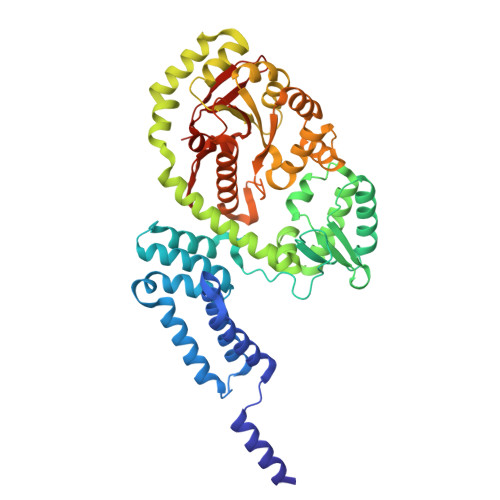Structural basis of inactivation of Ras and Rap1 small GTPases by Ras/Rap1-specific endopeptidase from the sepsis-causing pathogenVibrio vulnificus
Jang, S.Y., Hwang, J., Kim, B.S., Lee, E.Y., Oh, B.H., Kim, M.H.(2018) J Biol Chem 293: 18110-18122
- PubMed: 30282804
- DOI: https://doi.org/10.1074/jbc.RA118.004857
- Primary Citation of Related Structures:
6A7H, 6A8J - PubMed Abstract:
Multifunctional autoprocessing repeats-in-toxin (MARTX) toxins are secreted by Gram-negative bacteria and function as primary virulence-promoting macromolecules that deliver multiple cytopathic and cytotoxic effector domains into the host cytoplasm. Among these effectors, Ras/Rap1-specific endopeptidase (RRSP) catalyzes the sequence-specific cleavage of the Switch I region of the cellular substrates Ras and Rap1 that are crucial for host innate immune defenses during infection. To dissect the molecular basis underpinning RRSP-mediated substrate inactivation, we determined the crystal structure of an RRSP from the sepsis-causing bacterial pathogen Vibrio vulnificus ( Vv RRSP). Structural and biochemical analyses revealed that Vv RRSP is a metal-independent TIKI family endopeptidase composed of an N-terminal membrane-localization and substrate-recruitment domain (N lobe) connected via an inter-lobe linker to the C-terminal active site-coordinating core β-sheet-containing domain (C lobe). Structure-based mutagenesis identified the 2His/2Glu catalytic residues in the core catalytic domain that are shared with other TIKI family enzymes and that are essential for Ras processing. In vitro KRas cleavage assays disclosed that deleting the N lobe in Vv RRSP causes complete loss of enzymatic activity. Endogenous Ras cleavage assays combined with confocal microscopy analysis of HEK293T cells indicated that the N lobe functions both in membrane localization via the first α-helix and in substrate assimilation by altering the functional conformation of the C lobe to facilitate recruitment of cellular substrates. Collectively, these results indicate that RRSP is a critical virulence factor that robustly inactivates Ras and Rap1 and augments the pathogenicity of invading bacteria via the combined effects of its N and C lobes.
Organizational Affiliation:
From the Department of Biological Sciences, Korea Advanced Institute of Science and Technology, Daejeon 34141,; the Infection and Immunity Research Laboratory, Metabolic Regulation Research Center, Korea Research Institute of Bioscience and Biotechnology, Daejeon 34141, and.















